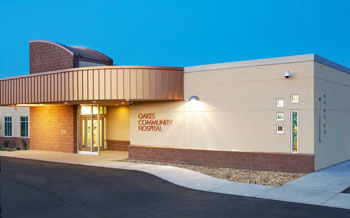Depression in Rural North Dakota: Could Telemedicine Level the Field?
by Jack Stacy
August 2017
When untreated, depression can be a crippling disease that makes maintaining relationships and keeping a job incredibly difficult. According to the Centers for Disease Control and Prevention (CDC), about 1 in 20 North Dakotans struggle with depression. Research also shows that rural citizens are even more likely to show symptoms than their urban counterparts. So, Oakes citizens might be at an even higher risk of depression than those in non-rural areas of the state. Nationwide, the CDC says that only about one third of patients experiencing severe depression have seen a mental healthcare professional in the last year. Because of the limited number of mental health specialists in rural settings, treatment options are even more limited. Oakes is no exception since the nearest psychiatrist works in Wahpeton. An appointment means a long car ride and at least a half day missed at work. If on a fixed income, these expenses may not be affordable.
 One potential
solution to the problem is telepsychiatry. Telepsychiatry
is a teleconference technology (think “FaceTime” or
“Skype”). It's used so that specialized health
professionals in a more populated area can see and
consult with patients in rural areas. The ER staff at
CHI Oakes
Hospital already uses telemedicine for difficult
cases. It's been very helpful, but it has its
limitations. For example, the surgeon in Fargo can't
reach through the computer screen to perform a procedure.
However, in a field like psychiatry where physical
examination takes a back seat to patient-provider
interaction, telemedicine seems to be a very attractive
opportunity for rural healthcare. Telepsychiatry is not
only convenient, but also effective. When compared to
traditional face-to-face therapy sessions, a recent study
showed that telepsychiatry is also successful in
relieving depressive symptoms.
One potential
solution to the problem is telepsychiatry. Telepsychiatry
is a teleconference technology (think “FaceTime” or
“Skype”). It's used so that specialized health
professionals in a more populated area can see and
consult with patients in rural areas. The ER staff at
CHI Oakes
Hospital already uses telemedicine for difficult
cases. It's been very helpful, but it has its
limitations. For example, the surgeon in Fargo can't
reach through the computer screen to perform a procedure.
However, in a field like psychiatry where physical
examination takes a back seat to patient-provider
interaction, telemedicine seems to be a very attractive
opportunity for rural healthcare. Telepsychiatry is not
only convenient, but also effective. When compared to
traditional face-to-face therapy sessions, a recent study
showed that telepsychiatry is also successful in
relieving depressive symptoms.
Though telepsychiatry is much more convenient than driving hours to see a psychiatrist, patients still have to visit a local clinic to access this technology. Sometimes people are embarrassed when visiting the clinic for mental healthcare, and this keeps many patients from seeking help. So, an even more convenient option is internet-based cognitive behavioral therapy (iCBT), an intimidating name for a surprisingly simple treatment option. The biggest advantage to iCBT is that it can be done in the comfort of your own home, as long as an internet connection is available. Here's how it works. The healthcare provider gives online questions and then uses the patient's answers to make a treatment lesson that teaches a patient what to do to improve their depression. To practice what they've learned, patients actually get homework assignments. So far, studies are showing that iCBT is effective, with most users having some relief. In fact, a study in the Journal of the American Medical Association recently concluded that iCBT led to more relief from depressive symptoms than traditional talk therapy.
Depression is more prevalent than most think, and it's a difficult disease to deal with, especially if access to treatment is limited. Telepsychiatry and iCBT have the potential to bring high quality mental healthcare right here to rural North Dakota. But, these are ideas for the future. So, if you're struggling with depression, don't hesitate to seek help right here in Oakes.
This article also appeared in the August 2017 issue of the Oakes Times.
About the Author
 Jack Stacy is a first year
medical student at the University of North Dakota's
School of Medicine and Health Sciences. As a participant
in the Center for Rural Health's Targeted Rural Health
Education (TRHE) project, Stacy has written this column
because of his interest in bringing medical information
to rural North Dakota citizens. The information is not
for diagnosis or treatment, and should not be used in
place of previous medical advice provided by a licensed
practitioner.
Jack Stacy is a first year
medical student at the University of North Dakota's
School of Medicine and Health Sciences. As a participant
in the Center for Rural Health's Targeted Rural Health
Education (TRHE) project, Stacy has written this column
because of his interest in bringing medical information
to rural North Dakota citizens. The information is not
for diagnosis or treatment, and should not be used in
place of previous medical advice provided by a licensed
practitioner.
